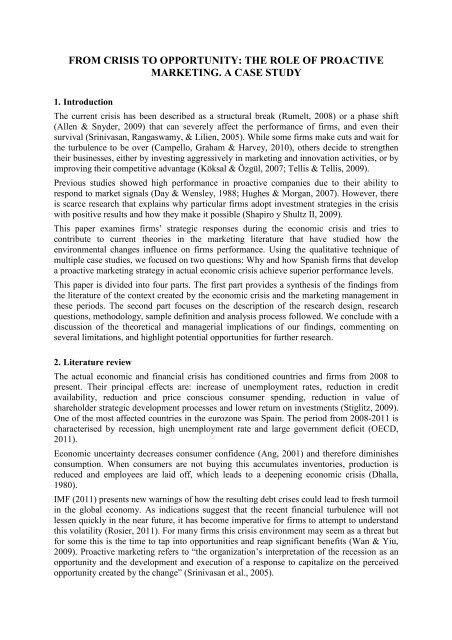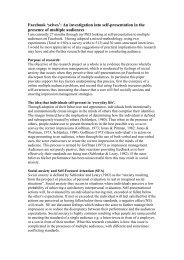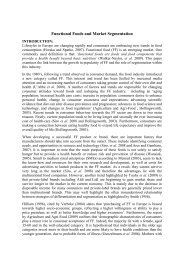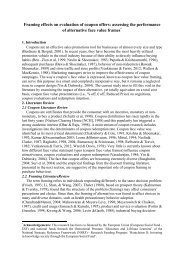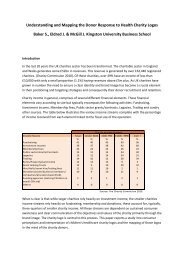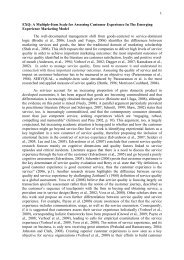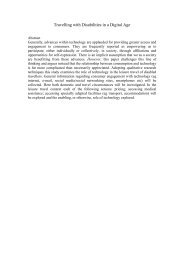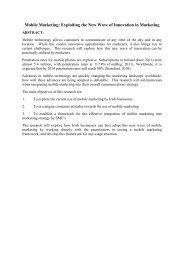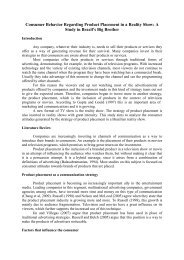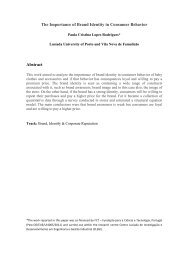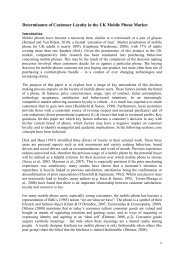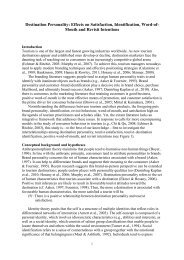from crisis to opportunity - Academy of Marketing
from crisis to opportunity - Academy of Marketing
from crisis to opportunity - Academy of Marketing
Create successful ePaper yourself
Turn your PDF publications into a flip-book with our unique Google optimized e-Paper software.
FROM CRISIS TO OPPORTUNITY: THE ROLE OF PROACTIVE<br />
MARKETING. A CASE STUDY<br />
1. Introduction<br />
The current <strong>crisis</strong> has been described as a structural break (Rumelt, 2008) or a phase shift<br />
(Allen & Snyder, 2009) that can severely affect the performance <strong>of</strong> firms, and even their<br />
survival (Srinivasan, Rangaswamy, & Lilien, 2005). While some firms make cuts and wait for<br />
the turbulence <strong>to</strong> be over (Campello, Graham & Harvey, 2010), others decide <strong>to</strong> strengthen<br />
their businesses, either by investing aggressively in marketing and innovation activities, or by<br />
improving their competitive advantage (Köksal & Özgül, 2007; Tellis & Tellis, 2009).<br />
Previous studies showed high performance in proactive companies due <strong>to</strong> their ability <strong>to</strong><br />
respond <strong>to</strong> market signals (Day & Wensley, 1988; Hughes & Morgan, 2007). However, there<br />
is scarce research that explains why particular firms adopt investment strategies in the <strong>crisis</strong><br />
with positive results and how they make it possible (Shapiro y Shultz II, 2009).<br />
This paper examines firms’ strategic responses during the economic <strong>crisis</strong> and tries <strong>to</strong><br />
contribute <strong>to</strong> current theories in the marketing literature that have studied how the<br />
environmental changes influence on firms performance. Using the qualitative technique <strong>of</strong><br />
multiple case studies, we focused on two questions: Why and how Spanish firms that develop<br />
a proactive marketing strategy in actual economic <strong>crisis</strong> achieve superior performance levels.<br />
This paper is divided in<strong>to</strong> four parts. The first part provides a synthesis <strong>of</strong> the findings <strong>from</strong><br />
the literature <strong>of</strong> the context created by the economic <strong>crisis</strong> and the marketing management in<br />
these periods. The second part focuses on the description <strong>of</strong> the research design, research<br />
questions, methodology, sample definition and analysis process followed. We conclude with a<br />
discussion <strong>of</strong> the theoretical and managerial implications <strong>of</strong> our findings, commenting on<br />
several limitations, and highlight potential opportunities for further research.<br />
2. Literature review<br />
The actual economic and financial <strong>crisis</strong> has conditioned countries and firms <strong>from</strong> 2008 <strong>to</strong><br />
present. Their principal effects are: increase <strong>of</strong> unemployment rates, reduction in credit<br />
availability, reduction and price conscious consumer spending, reduction in value <strong>of</strong><br />
shareholder strategic development processes and lower return on investments (Stiglitz, 2009).<br />
One <strong>of</strong> the most affected countries in the eurozone was Spain. The period <strong>from</strong> 2008-2011 is<br />
characterised by recession, high unemployment rate and large government deficit (OECD,<br />
2011).<br />
Economic uncertainty decreases consumer confidence (Ang, 2001) and therefore diminishes<br />
consumption. When consumers are not buying this accumulates inven<strong>to</strong>ries, production is<br />
reduced and employees are laid <strong>of</strong>f, which leads <strong>to</strong> a deepening economic <strong>crisis</strong> (Dhalla,<br />
1980).<br />
IMF (2011) presents new warnings <strong>of</strong> how the resulting debt crises could lead <strong>to</strong> fresh turmoil<br />
in the global economy. As indications suggest that the recent financial turbulence will not<br />
lessen quickly in the near future, it has become imperative for firms <strong>to</strong> attempt <strong>to</strong> understand<br />
this volatility (Rosier, 2011). For many firms this <strong>crisis</strong> environment may seem as a threat but<br />
for some this is the time <strong>to</strong> tap in<strong>to</strong> opportunities and reap significant benefits (Wan & Yiu,<br />
2009). Proactive marketing refers <strong>to</strong> “the organization’s interpretation <strong>of</strong> the recession as an<br />
<strong>opportunity</strong> and the development and execution <strong>of</strong> a response <strong>to</strong> capitalize on the perceived<br />
<strong>opportunity</strong> created by the change” (Srinivasan et al., 2005).
Indeed, the environment plays a major role in shaping firms’ business strategies (Teece,<br />
Pisano & Shuen, 1997). While rivals are conserving resources, managers who take strategic<br />
action <strong>to</strong> improve their firm’s performance achieve more favorable consequences through<br />
amplified marketing efforts. Thus, marketing can be significantly more important <strong>to</strong> the firm<br />
during a recession than at any other time (O'Malley, S<strong>to</strong>ry & O'Sullivan, 2011).<br />
Firms are faced with two dilemmas, retrenchment or investment, or do both at the same time<br />
(Kitching, Blackburn, Smallbone & Dixon, 2009). The retrenchment, especially in marketing<br />
activities, is the instinctive response <strong>to</strong> the economic <strong>crisis</strong> in order <strong>to</strong> focus on conserving<br />
scarce resources with the hope <strong>of</strong> surviving until the economy recovers. Notwithstanding,<br />
strong evidence support the maintenance <strong>of</strong> marketing activities (Rodas & Stelter, 2009), as<br />
found in several studies that reflect that strategies focused on investment, innovation and<br />
market diversification, lead <strong>to</strong> higher levels <strong>of</strong> performance (Srinivasan et al., 2005; Naidoo,<br />
2010).<br />
O'Malley et al. (2011) show that arguments for invest in marketing during a recession include:<br />
maintaining a firm’s competitive advantage in difficult times, responding <strong>to</strong> changes in<br />
cus<strong>to</strong>mer behavior and the need <strong>to</strong> maintain the firm’s value; consolidating key brand values<br />
such as leadership and innovation, brand equity, convenience and tradition (Nielsen, 2010).<br />
However, whilst some <strong>of</strong> the studies in the literature emphasize in general company measures<br />
taken in an economic <strong>crisis</strong> and identify the importance <strong>of</strong> strategies <strong>to</strong> improve sales figures,<br />
there is a distinct lack <strong>of</strong> investigation in respect <strong>to</strong> marketing strategy changes (Köksal &<br />
Özull, 2007). Therefore, we pursue an academic effort <strong>to</strong> bridge the gaps in our understanding<br />
<strong>of</strong> the appropriate choice and relative effectiveness <strong>of</strong> marketing response in economic <strong>crisis</strong>,<br />
in order <strong>to</strong> generate insights that can guide firms in their decision making during the <strong>crisis</strong><br />
(Srinivasan et al., 2005).<br />
3. Research Design<br />
3.1. Research questions and methodology<br />
Through this explora<strong>to</strong>ry study, the objective is <strong>to</strong> determine “why” and “how” Spanish firms<br />
that develop a proactive marketing strategy in actual economic <strong>crisis</strong> achieve superior<br />
performance levels. The use <strong>of</strong> qualitative methods is appropriate when studying complex<br />
processes (Eisenhardt, 1989; Yin, 2009). We chose a multiple case study due <strong>to</strong> the complex<br />
nature <strong>of</strong> the issue, and the need <strong>to</strong> take in<strong>to</strong> account a large number <strong>of</strong> variables. According<br />
<strong>to</strong> Eisenhardt (1989), we use secondary data and multiple interviews in each case in order <strong>to</strong><br />
develop a rich vision and provide the basis for further transfer <strong>of</strong> results <strong>to</strong> other contexts.<br />
The questions focused on gaining a descriptive perception <strong>of</strong> the <strong>crisis</strong> and the impact on the<br />
organization, particularly in the performance; the role <strong>of</strong> marketing in the firm, the changes in<br />
strategy and marketing activities, especially in the marketing mix; the mechanisms <strong>to</strong> adapt <strong>to</strong><br />
environmental changes and the behavior <strong>of</strong> the budgets for this area.<br />
3.2. Sample, field work and analysis process.<br />
The research was conducted with Spanish companies that maintained or increased their<br />
marketing activities and also obtained a similar or better performance during the current<br />
economic <strong>crisis</strong>. The following were used as selection criteria: diversity <strong>of</strong> economic sec<strong>to</strong>rs<br />
and size, and this in order <strong>to</strong> eliminate bias in the results regarding the availability <strong>of</strong> human,<br />
financial and technological resources. The sample firms were identified through specialized<br />
websites on marketing and economics, as well as newspapers and magazines <strong>of</strong> the same
nature. From an initial list <strong>of</strong> 20 firms, direct contact was taken with the marketing manager<br />
and marketing representative using LinkedIn. The group <strong>of</strong> six companies that comprise the<br />
sample was defined depending on the availability <strong>of</strong> people. The sample size is based on the<br />
adoption <strong>of</strong> the criterion <strong>of</strong> theoretical saturation (Glasser & Strauss, 1967) and<br />
recommendation <strong>of</strong> Eisenhardt (1989), considering appropriate a range between four and ten<br />
cases.<br />
The participating firms are: i) Damm group: Spanish company manufacturing and distributing<br />
drinks, primarily beer. It has a market share <strong>of</strong> 25%. ii) Nutrexpa, one <strong>of</strong> the most important<br />
groups in Spanish food sec<strong>to</strong>r. It has international presence in Portugal, Chile and China. (iii)<br />
LEDS-C4 is a manufacturer <strong>of</strong> lighting solutions. It has over 2,500 references. (iv) Even<strong>to</strong><br />
Plus: Business group that provides platforms and solutions for pr<strong>of</strong>essionals and providers <strong>of</strong><br />
corporate events such as fairs, congresses and below the line marketing activities. (v)<br />
Energivity Consulting: Consultant training in sales and marketing, with emphasis on small<br />
and medium enterprises, and (vi) The Cosmetic Republic: Hair cosmetics company with sells<br />
in Europe, Asia and Latin America. Table 1 presents a summary <strong>of</strong> the cases.<br />
Company<br />
Table 1. Companies involved in the Case Study<br />
Damm Group Nutrexpa Leds C4 Even<strong>to</strong> Plus<br />
Energivity<br />
Consulting<br />
The Cosmetic<br />
Republic<br />
Activity Food-drinks Food Lighting Event industry Consulting Cosmetics<br />
Size/ employees Big / 2.153 Big / 1800 Big / 325 Small / 18 Small / 6 Small / 10<br />
Sales<br />
Source: Own elaboration.<br />
2008 754 million € 500 million € 44 million € 1.2 million € 185,000 € 400,000 €<br />
2009 782 million € 480 million € 38 million € 1.2 million € 340,000 € 700,000 €<br />
2010 790 million € 500 million € 40.5 million € 1.5 million € 450,000 € 1 million €<br />
Fieldwork was conducted during March and April 2011. Semi-structured interview<br />
techniques, direct observation and secondary data analysis were used in order <strong>to</strong> contextualize<br />
the interviews. We developed an interview pro<strong>to</strong>col, tested with an expert, and adapted with<br />
the first two interviews. Interviews were conducted by one researcher. Interviews were<br />
transcribed using F4 Transcriptions V.3.1 s<strong>of</strong>tware and processed with Atlas TI v.6.<br />
4. Results<br />
This section explains the findings that have emerged <strong>from</strong> the present analysis, based on the<br />
examination <strong>of</strong> the six cases described above. We sought <strong>to</strong> answer why and how the firms<br />
have managed the marketing strategy during the actual economic <strong>crisis</strong>.<br />
For all firms interviewed, the <strong>crisis</strong> has forced them <strong>to</strong> revise many processes and optimize<br />
resources <strong>to</strong> fit the situation. In this context, the <strong>crisis</strong> may be both a threat and an<br />
<strong>opportunity</strong>. Thus, firms take advantage <strong>of</strong> opportunities <strong>to</strong> ensure the liquidity and planning<br />
the growth, especially through the internationalization or new acquisitions. For example, for<br />
Damm Group the ideal model <strong>of</strong> internationalization is through strategic alliances or<br />
acquisitions in favorable conditions. The fac<strong>to</strong>ry <strong>of</strong> Santarem (Portugal) was acquired in 2010<br />
and has strengthened their international strategy. Nutrexpa in 2008, acquired the Spanish<br />
largest biscuit firm for a very low price, consolidating the strategy <strong>of</strong> acquisition <strong>of</strong> leading<br />
brands, and expanding and enhancing its product <strong>of</strong>fer.
Besides the finding and opening <strong>of</strong> new markets <strong>to</strong> compensate the difficult situation <strong>of</strong> the<br />
Spanish market, the analyzed firms have adapted their business models and the products and<br />
services portfolio <strong>to</strong> the new conditions, rethinking its organizational design <strong>to</strong> be more<br />
efficient and prioritizing the short-term vision, providing flexibility and rapid response <strong>to</strong><br />
changing conditions, keys aspects during periods <strong>of</strong> uncertainty (Hartman 2009).<br />
<strong>Marketing</strong> is a strategic function that maintains an essential link between the cus<strong>to</strong>mer and<br />
various processes within the firm (Day, 1994). Each case defines marketing as essential in the<br />
current strategy <strong>of</strong> survival and strengthening. The firms achieve consumer confidence<br />
keeping the promise <strong>of</strong> quality, and proximity through an emotional speech. Firms have<br />
unders<strong>to</strong>od that they have <strong>to</strong> connect with the client, who is more demanding and selective,<br />
and with less income. Leds C4 changed their production orientation <strong>to</strong>ward a cus<strong>to</strong>mer focus,<br />
adding <strong>to</strong> their standard product lines the Special Projects Division, which develops and<br />
manufactures lamps <strong>to</strong> order. While Energivity Consulting reduced its range <strong>of</strong> action <strong>to</strong><br />
minimize travel times, so that they can dedicate more time and attention <strong>to</strong> each client.<br />
Considering the classic marketing mix, all variables have been affected during the <strong>crisis</strong>. In<br />
the current market situation, the cus<strong>to</strong>mer is more sensitive <strong>to</strong> price changes. Even<strong>to</strong> Plus, for<br />
example, has chosen <strong>to</strong> <strong>of</strong>fer package services and optimize costs. Damm, meanwhile, has<br />
believed that the key fac<strong>to</strong>r is <strong>to</strong> get a product that stands out for its price-value relation, and<br />
<strong>to</strong> create a special feeling with the cus<strong>to</strong>mer. Despite the competence reaction <strong>to</strong> reduce the<br />
price, analyzed companies maintained the prices.<br />
Advertising and communication have focused on highlighting the brands through more<br />
rational and emotional messages. While competi<strong>to</strong>rs have cut their advertising activities and<br />
budgets, our six cases continued their activities and campaigns, reaching the highest consumer<br />
recall, particularly Nutrexpa and Damm in the mass media. The coincidence <strong>of</strong> the rise <strong>of</strong><br />
digital social networks with the <strong>crisis</strong> period has triggered a new way <strong>to</strong> communicate directly<br />
with their clients. Growing social media marketing budgets is being so common, particularly<br />
in smaller companies. Nowadays the investment in communication is more selective and<br />
constant, always looking for a guaranteed ROI. In this way, advertising during a <strong>crisis</strong> not<br />
only helps <strong>to</strong> engage cus<strong>to</strong>mers, also helps <strong>to</strong> maintain shareholder´s confidence and therefore<br />
helps <strong>to</strong> maintain the value <strong>of</strong> a firm (O'Malley et al., 2011).<br />
Concerning the product variable, in large firm’s cases like Damm, Nutrexpa and Leds C4,<br />
there´s evidence <strong>of</strong> multidisciplinary and multi area work, especially in R&D, in order <strong>to</strong><br />
develop adapted products with new materials and technologies <strong>to</strong> <strong>of</strong>fer attractive products.<br />
This is consistent with Tubbs (2007), who stated that firms that invest in R&D and product<br />
development during recessions find it easier <strong>to</strong> capture market share and cus<strong>to</strong>mer loyalty.<br />
For the marketing pr<strong>of</strong>essionals interviewed, innovation is a fundamental firm ability <strong>to</strong> adapt<br />
and compete, because it facilitates <strong>to</strong> change its products and processes faster than<br />
competi<strong>to</strong>rs, achieving greater pr<strong>of</strong>itability and better options when recovery comes. For The<br />
Cosmetic Republic case, innovation is connected and opened, with the aim <strong>to</strong> identify market<br />
needs and desires. Leds C4 used a mix <strong>of</strong> in-house innovation with open innovation processes<br />
with design studios and engineering firms, something very common in the two analyzed food<br />
companies, which launches a large number <strong>of</strong> products every year.<br />
A common denomina<strong>to</strong>r emerges: companies and their direc<strong>to</strong>rs are inclined <strong>to</strong> take businessrelated<br />
risks, and promote change as a way <strong>to</strong> gain a competitive advantage (Srinivasan et al.,<br />
2005). While competi<strong>to</strong>rs have cut the budget in an indiscriminate way, these organizations<br />
have adapted their strategies <strong>to</strong> the economic context and consumer behavior. The<br />
interviewees mentioned the use <strong>of</strong> completely flexible marketing plans, which vary according<br />
the changing environmental conditions in order <strong>to</strong> exploit all the opportunities it <strong>of</strong>fers.
Keeping marketing budgets, especially in advertising, has been fundamental <strong>to</strong> maintain<br />
leadership in the areas where each company operates. In general, the plans are more realistic,<br />
with budgets linked <strong>to</strong> a clear intention and thinking about the income statement.<br />
<strong>Marketing</strong> literature suggests that firms use their capabilities <strong>to</strong> transform resources in<strong>to</strong><br />
outputs based on their marketing mix strategies and that such marketing capabilities is linked<br />
<strong>to</strong> their business performance. The marketing resources demonstrated which market-based<br />
resources, such as cus<strong>to</strong>mer-linking capabilities, reputational assets, market innovation<br />
capabilities, and human resource assets, affect performance outcomes (Hooley, Gordon,<br />
Greenley, Cadogan, & Fahy, 2005).<br />
In summary, these analyzed companies have seen the <strong>crisis</strong> as an <strong>opportunity</strong> <strong>to</strong> strengthen<br />
their businesses, invest aggressively and overtake their weaker competi<strong>to</strong>rs. This proactive<br />
stance in hostile environments has resulted in a positive impact on performance (Covin &<br />
Slevin, 1989), as evidenced by the sales achieved by each <strong>of</strong> the companies in the years 2008,<br />
2009 and 2010 (see Table 1). The study results give evidence <strong>of</strong> the efforts <strong>to</strong> identify and<br />
consolidate a proactive marketing response in <strong>crisis</strong> periods, enhancing their competitive<br />
advantage, the strategic emphasis on marketing, a market orientation, the marketing<br />
innovation and an entrepreneurial culture.<br />
5. Conclusions, Limitations and Future Research<br />
This explora<strong>to</strong>ry study addresses two questions, why and how Spanish companies develop<br />
proactive marketing strategy and get better performance in <strong>crisis</strong>. Although there is strong<br />
theoretical and practical evidence that maintaining or increasing marketing activities during<br />
crises provide significant advantages, marketing budgets are <strong>of</strong>ten under pressure (O'Malley<br />
et al., 2011). Thus, perceiving the recession as an <strong>opportunity</strong> is not enough <strong>to</strong> make a firm<br />
proactive, the firm must also be able <strong>to</strong> develop and implement a marketing program <strong>to</strong><br />
capitalize on the <strong>opportunity</strong> (Srinivasan et al., 2005).<br />
Thus, the analyzed firms demonstrate the strategic role <strong>of</strong> marketing <strong>to</strong> provide value <strong>to</strong> firms<br />
and ensure their survival in times <strong>of</strong> <strong>crisis</strong>. The cases show that aspects such as innovation,<br />
market orientation, the strategic emphasis on marketing and entrepreneurial culture are keys<br />
<strong>to</strong> proactively respond <strong>to</strong> the <strong>crisis</strong> and improve performance. All firms included in this study<br />
evidence that in <strong>crisis</strong> times successful firms anticipate changing marketing conditions,<br />
respond <strong>to</strong> cus<strong>to</strong>mer needs and compete by <strong>of</strong>fering superior value (MSI, 2010).<br />
This study suggests several implications: Considering the position <strong>of</strong> the MSI (2010),<br />
educa<strong>to</strong>rs and business leaders have <strong>to</strong> recognize, appreciate, and understand the significance<br />
<strong>of</strong> marketing in the dynamic but turbulent global world, and <strong>to</strong> propose new paradigms for<br />
marketing’s prosperity and firm survival. In terms <strong>of</strong> limitations, it´s important <strong>to</strong> highlight<br />
the sample size, being able <strong>to</strong> expand it <strong>to</strong> more firms in other sec<strong>to</strong>rs and economic activities.<br />
However, the case study methodology does not perceive this as a limitation, but as an<br />
<strong>opportunity</strong> <strong>to</strong> enrich the knowledge about a <strong>to</strong>pic. Also, this is an explora<strong>to</strong>ry work, so that<br />
future research should help <strong>to</strong> understand better the phenomenon.<br />
Among the future lines <strong>of</strong> research, could be considered: (i) <strong>to</strong> extend this case study <strong>to</strong> other<br />
contexts, (ii) <strong>to</strong> conduct a quantitative study <strong>to</strong> identify whether the companies that manage a<br />
proactive marketing in times <strong>of</strong> <strong>crisis</strong> get superior results compared <strong>to</strong> those who cut their<br />
marketing budgets and act conservatively, (iii) <strong>to</strong> conduct a longitudinal study <strong>to</strong> determine<br />
whether the companies that implement a proactive marketing in times <strong>of</strong> <strong>crisis</strong> achieve better<br />
performance levels in recovery.
6. References<br />
Allen, R., & Snyder, D. (2009). New thinking on the financial <strong>crisis</strong>. Critical perspectives on<br />
international business, 1/2 (5), 36-55. doi: 10.1108/17422040910938677<br />
Ang, S. (2001). Crisis marketing: a comparison across economic scenarios. International<br />
Business Review, (10), 263–284. doi: 10.1016/S0969-5931(01)00016-6<br />
Campello, M., Graham, J. R., & Harvey, C. (2010). The real effects <strong>of</strong> financial constraints:<br />
Evidence <strong>from</strong> a financial <strong>crisis</strong>. Journal <strong>of</strong> Financial Economics, 97(3), 470-487. doi:<br />
10.1016/j.jfineco.2010.02.009<br />
Covin, J.G., & Slevin, D.P. (1989). Strategic management <strong>of</strong> small firms in hostile and benign<br />
environments. Strategic Management Journal, 10(1), 75-87. doi: 10.1002/smj.4250100107<br />
Day, G. (1994). The capabilities <strong>of</strong> market-driven organizations. Journal <strong>of</strong> <strong>Marketing</strong>,<br />
58(11), 37–52. doi: 10.2307/1251915<br />
Day, G. S., & Wensley, R. (1988). Assessing advantage: A framework for diagnosing<br />
competitive superiority, Journal <strong>of</strong> <strong>Marketing</strong>, 52, 1-20. doi:<br />
Dhalla, N.K. (1980). Advertising as an antirecession <strong>to</strong>ol. Harvard Business Review, 58, 158–<br />
165.<br />
Eisenhardt, K. M. 1989. Building Theories <strong>from</strong> Case Study Research. <strong>Academy</strong> <strong>of</strong><br />
Management Review, 14(4), 532-550. doi: 10.2307/258557<br />
Glasser, B.G., & Strauss, L. (1967). The discovery <strong>of</strong> grounded theory. Strategies for<br />
qualitative research. Hauthorne: Gruyter.<br />
Hartman, N. (2009). Sure ways <strong>to</strong> tackle uncertainty in <strong>to</strong>ugh times. Financial Times,<br />
Managing in a Downturn Series. Retrieved <strong>from</strong><br />
http://www.ft.com/reports/managingdownturn<br />
Hooley, G.J., Gordon E., Greenley, G.E., Cadogan, J.W., & Fahy, J. (2005). The performance<br />
impact <strong>of</strong> marketing resources. Journal <strong>of</strong> Business Research, 58, 18– 27. doi:<br />
10.1016/S0148-2963(03)00109-7<br />
Hughes, M. & Morgan, R. (2007). Deconstructing the relationship between entrepreneurial<br />
orientation and business performance at the embryonic stage <strong>of</strong> firm growth. Industrial<br />
<strong>Marketing</strong> Management, 36, 651–661. doi:10.1016/j.indmarman.2006.04.003<br />
International Monetary Fund (2011). World Economic Outlook. Slowing Growth, Rising<br />
Risks. Retrieved <strong>from</strong> http://www.imf.org/external/pubs/ft/weo/2011/02/index.htm<br />
Kitching, J., Blackburn, R., Smallbone, D., & Dixon, S. (2009). Business Strategies and<br />
Performance During Difficult Economic Conditions, BIS. Retrieved <strong>from</strong>:<br />
britishdesigninnovation.org<br />
Köksal, M.H., & Özgül, E. (2007). The relationship between marketing strategies and<br />
performance in an economic <strong>crisis</strong>. <strong>Marketing</strong> Intelligence & Planning, 25, 326–342. doi:<br />
10.1108/02634500710754574<br />
MSI - <strong>Marketing</strong> Science Institute. (2010). 2010 - 2012 Research Priorities. Retrieved <strong>from</strong><br />
http://www.msi.org/research/index.cfm?id=271#RP1<br />
Naidoo, V. (2010). Firm survival through a <strong>crisis</strong>: The influence <strong>of</strong> market orientation,<br />
marketing innovation and business strategy. Industrial <strong>Marketing</strong> Management, articles in<br />
press.<br />
Nielsen (2010). La importancia del valor de las marcas. Retrieved <strong>from</strong> www.nielsen.com<br />
OECD. (2011). Perspectives: Spain Policies for a sustainable recovery. Retrieved <strong>from</strong><br />
http://www.oecd.org/dataoecd/45/46/44686629.pdf<br />
O'Malley, L., S<strong>to</strong>ry, V., & O'Sullivan, V. (2011). <strong>Marketing</strong> in a recession: retrench or<br />
invest?. Journal <strong>of</strong> Strategic <strong>Marketing</strong>, 19(3), 285–310. doi:<br />
10.1080/0965254X.2011.581386
Rhodes, D., & Slater, D. (2009). Seize Advantage in a downturn. Harvard Business Rev,<br />
87(2), 50-58. doi: 201.158.33.230<br />
Rosier, E. (2011). <strong>Marketing</strong> strategy in a turbulent environment. Journal <strong>of</strong> Strategic<br />
<strong>Marketing</strong>, 19 (5), 413–419. doi: 10.1080/0965254X.2011.613556<br />
Rumelt, R. (2008). Strategy in a "Structural Break”. McKinsey Quarterly, 1, 35-42. Stable<br />
URL: http://www.mckinseyquarterly.com/strategy_in_a_structural_break_2257<br />
Shapiro, S., & Shultz II, C. (2009). Macromarketing, controversy and economic development.<br />
Just before and now during the global meltdown. European Business Review, 21(4), 313-<br />
325. doi: 10.1108/09555340910970427<br />
Srinivasan, R., Rangaswamy, A., & Lilien, G. (2005). Turning Adversity in<strong>to</strong> Advantage:<br />
Does Proactive <strong>Marketing</strong> During a Recession Pay Off? International Journal <strong>of</strong> Research<br />
in <strong>Marketing</strong>, 22(2), 109-125. doi: 10.1016/j.ijresmar.2004.05.002<br />
Stiglitz, J. (2009). The Current Economic Crisis and Lessons for Economic Theory. Eastern<br />
Economic Journal, 35, 281–296. doi: 10.1057/eej.2009.24<br />
Teece, D.J., Pisano, G. & Shuen, A. (1997). Dynamic capabilities and strategic marketing.<br />
Strategic Management Journal, 18(7), 509-33. Stable URL:<br />
http://www.js<strong>to</strong>r.org/stable/3088148<br />
Tellis, G.J., & Tellis, K. (2009). Research on advertising in a recession: A Critical Review<br />
and Synthesis. Journal <strong>of</strong> Advertising Research, 49(3), 304–327. Stable URL:<br />
http://ssrn.com/abstract=1378562<br />
Tubbs, M. (2007). The relationship between R&D and company performance. Research<br />
Technology Management, 50(6), 23-30. Industrial Research Inst, Inc. Retrieved <strong>from</strong><br />
http://www.scopus.com/inward/record.url?eid=2-s2.0-<br />
6749067769&partnerID=40&md5=fd94bbc0bc6ba0ab4dbdaeeb9f18a725<br />
Wan, W., & Yiu, D. (2009). From <strong>crisis</strong> <strong>to</strong> <strong>opportunity</strong>: environmental jolt, corporate<br />
acquisitions, and firm performance. Strategic Management Journal, 30, 791–801. doi:<br />
10.1002/smj.744<br />
Yin, R. (2009). Case Study Research: Design and Methods, London: Sage Publications.


